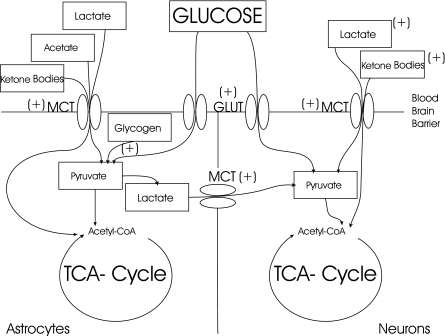FIG. 1.
Two-compartment model of brain metabolic fluxes along with pathways that have been proposed to be upregulated in intensively treated type 1 diabetes. Both astrocytes and neurons are dependent on glucose as a metabolic substrate, but neurons to a higher degree than astrocytes—particularly under hypoglycemia. Storage of glycogen allows astrocytes to provide neurons with an energy reserve that can be quickly mobilized and transferred during times of intense activity as well as during hypoglycemia; whether its levels are increased in type 1 diabetes still remains unclear (17). Monocarboxylic acid transporters (MCTs) along the blood brain barrier allow uptake of acetate, lactate, and ketone bodies and may be upregulated in type 1 diabetes (18,24) allowing increased alternate fuel consumption during hypoglycemia (indicated by +). Glucose transporters (GLUT) may be upregulated in a similar fashion in type 1 diabetes (20).

